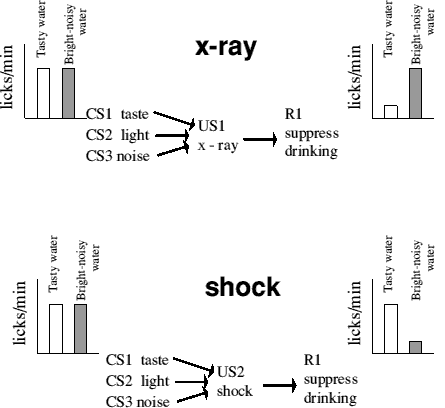

222@18
Equipotentiality states that the stimulus chosen as the CS is not important.
Long-delayed flavor aversions.
Unique characteristics:
1) long ISI delay
2) virtually inextinguishable
obtained in 1 trial
Design:
Novel flavor consumed by multi-dieted species (rat, human etc/ not Koala) if followed hours (4-6) by an injection of a toxin (lithium) will cause a classically conditioned taste aversion.
Page 2
Role
of John Garcia

CS > Flavor (vinegar)
UCS (toxin)
CR aversion in 1 trial and with a long ISI.
Ramifications: Forces one to review Pavlov and ISI rules governing classical conditioning. Forces us to think about the genetic/biological nature of the learner.
Some conditioning, apparently is extremely supraprepared like flavor aversions (1 trial, long ISI) –
some prepared (like light >shock) and some contraprepared (like noise >sickness). Preparedness
1) Prepared associations an innate propensity to form some CS-US associations quickly because of the animal's biological makeup.
3
2)
Contraprepared associations refers to the difficulty in forming some CS-US
associations because of the animal's biology.
3) Unprepared associations are CS-US associations formed after a moderate number of trials; the animal does not have any particular biological for these
predispositions.
4
BRIGHT NOISY EXPERIMENT Garcia and Koelling, 1966)
Applications.
Classic studies in Conditioning and
Learning
Garcia Taste Aversion Study

Bright Noisy Water Experiment
Taste Aversion Learning Study
5 Phase 1 -- Rats are divided into the following three groups: Group 1 -- Emitic drug will be given after Phase 2, rats get sick ½ hr. later.
Group 2 -- X-rays will be given after Phase 2, rats get sick ½ hr. later.
Group 3 -- Each lick during Phase 2 is followed by a painful electric shock..
Phase 2 -- All rats have ten minutes access to water. The water has a slightly salty taste. Each
lick produces a click and flash of light.
Phase 3 -- The next day (rats in groups 1 and 2 have recovered), the rats are again offered
water. The rats in each of the three main treatment groups are further subdivided into three
groups, each offered water accompanied by only one of the three potential CSs -- salty taste,
light
flash, or tone. The results for the nine subgroups

Conclusion:
Animals are biologically prepared to make some associations easier than
others.Applications
7 Application 1
